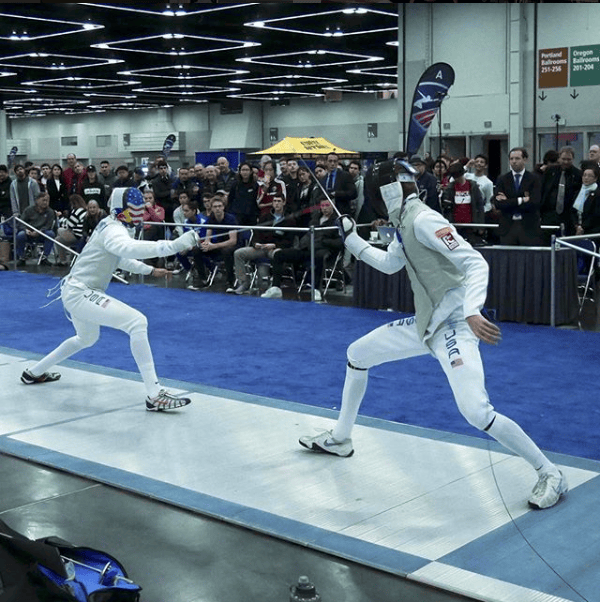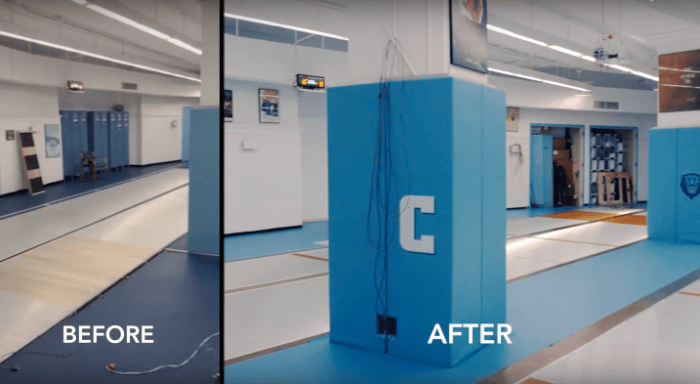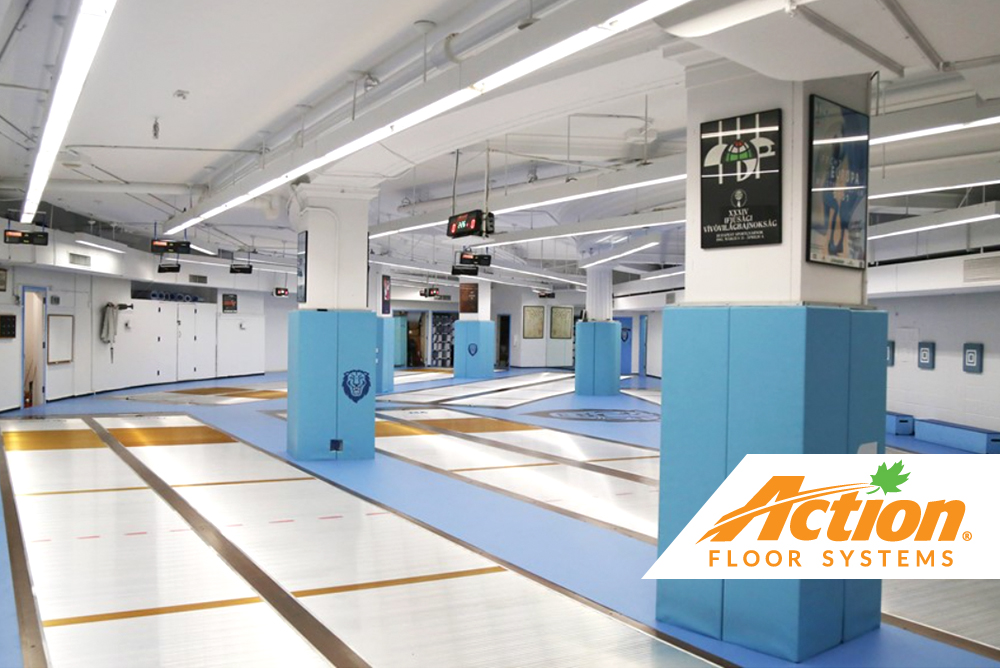Fencing, practiced for thousands of years as a form of military training, evolved into a beloved sport around the 15th century. For over a millennium, few trailblazing innovations to the playing surface have occurred, until now.
The Challenge
Olympic and competitive fencers have been crying out for years over the unforgiving properties of traditional fencing floors. Fencing strips are typically placed on top of hard flooring such as concrete or marble, increasing the likelihood of injuries to the lower back, knees, and hips. That’s why Radical Fencing stepped in and invented a better portable sports floor for fencing. It provides beneficial shock absorption that protects athletes and allows teams to take the floor with them if practice spaces change. Moreover, what makes it truly game-changing, however, is how the design conceals wires and cables that are necessary to the sport, but cumbersome to replace, and an obvious safety hazard.
The verb to fence is derived from the noun fence, originally meaning the act of defending. It would only be appropriate that Radical Fencing would invent a flooring system created specifically to protect and defend fencing athletes.
Radical Fencing is a creator of fencing products, from fencing gear to components and, most recently, their portable resilient floating floor system. And, Action Floor Systems is proud to help pioneer the first floating fencing floor at Columbia University alongside the innovators and owner at Radical Fencing.
The Columbia Lions fencing team first discovered and tested the modular floor design during the 2015 Ivy League Championships. After Radical Fencing brought in one of its strips for testing, Columbia Lions Head Coach Michael Aufrichtig liked what he saw and began to plan for its large-scale implementation thereafter.
Radical Fencing needed a manufacturer that could carry out the construction. They knew Action Floors would be a solid resource and collaborator due to our experience with sports floor systems and portable designs.
To successfully complete this project as a team, flooring and fencing issues needed to be understood and addressed.
The Process
Addressing Issue No. 1
The need for a sports floor with shock absorption was one of the primary motivators driving this innovation.
“When you look at older generations of fencers, including Olympic athletes, many are out of the sport because of knee, hip, and ankle problems,” Radical Fencing Owner Phillippe Bennett shares. “Those are problems that have evolved over the course of their playing career – many years of playing on hard surfaces.”
Bennett explains that this is also a major issue with younger, growing fencers. Pain and soreness in their hips, shins, and knees can quickly discourage them. “Like shin splits with a runner,” adds Bennett, “you have to wait to heal; it’s painful and it can put you out of practice.”
To address the issue, Action Floors suggested a system designed for resilience, combining a custom Action NitroPanel® system with top-of-the-line subflooring.
“The new sports floor system allows athletes to train longer with fewer injuries due to the careful engineering of shock absorbing properties and supportive padding,” says Action Floors Technical Director Don Brown. “It was designed so the athlete would be less likely to get sore muscles, joints, and knees due to a hard playing surface.”
“The head coach has expressed that this year he’s had longer practice sessions, fewer injuries, and people feeling better at the end of training due to the new floor system,” adds Bennett.
Addressing Issue No. 2
One of the major features of this new 5,500 square foot floor system is the room has a flush, even surface and has no exposed cabling or wiring. All conductive metal fencing panels are positioned flush with the surrounding wood non-fencing surface with wires and cables positioned underneath the floor panel system.
All these features were unheard of in the fencing world until now. Normally the wires and cables, required for scoring systems, typically move with the fencer and are positioned along the top surface. Plus, the metal fencing strip is normally positioned on top of the non-fencing floor, requiring athletes to step up and down off the fencing strip to avoid tripping over the wires and cables.
“The wires are very susceptible to people crossing, walking over them, and breaking them,” explains Bennett.
When this happens, fencers can get injured and broken equipment results in downtime. A broken wire can make a surface inoperable. The more time you spend repairing, the less time and resources you have for practicing and playing.
“It’s not like a light bulb that goes out and you can screw a new one in,” adds Bennett. “Fixing a broken wire takes time and can’t be done immediately.”

Traditional fencing surface with exposed wires and uneven surfaces
The new fencing floor system solves this common problem in two ways. First, the new design incorporates channels underneath the surface to hide and organize cords and wires. Cords now move with the athlete and reel in to remove slack. Additionally, the floor was manufactured so the fencing strip fits into the system rather than sitting on top.
Since installation at Columbia University, the fencing team has not had a broken wire in over a year. While this most importantly means athletes are staying safe, it also shows equipment is not being broken.
Addressing Issue No. 3
Before kicking off the project, Radical Fencing shared another common issue with fencing facilities. “We learned that a lot of clubs don’t own their space, in fact, they’re leasing them,” shares Brown.
With a customized Action NitroPanel® portable sports floor system, pieces interlock and can be easily uninstalled and reinstalled at any time.
“The portable floor allows Columbia University to bring their fencing floor system with them if space changes,” adds Brown. “It’s the definition of a true investment: one the team intends to keep with them for the long haul whether it remains in the basement or moves to a new location.”
The Results
 Before the renovation, the fencing room included eight strips, none of which were Olympic size. Now, the room has nine total strips, six of which are regulation length, and all of which are regulation width.
Before the renovation, the fencing room included eight strips, none of which were Olympic size. Now, the room has nine total strips, six of which are regulation length, and all of which are regulation width.
As for the collaboration between Radical Fencing and Action Floors, Bennett praises the partnership.
“Just like how athletes on a soccer team defend each other to ultimately score points, the relationship between Radical Fencing and Action Floors has been positive,” shares Bennett. “Action Floors has been there with us from the beginning and we appreciate the fact that they’re an American company.”
Action Floors was honored to work alongside the innovators at Radical Fencing on this project. The fencing team at Columbia University is beyond pleased with their new fencing surface, which allows for more playing space, keeps their joints protected, and improves overall safety and efficiency with hidden cords and a level surface.
To learn more about the possibilities of sports floor systems, discover how our sports floor systems can be used for a variety of end uses, from doggy daycares to music halls, and multi-court basketball facilities. Projects like this show how customizable Action Floors’ sports floor systems can be. Shoot us a message today to collaborate – whether your project is a basketball court or something entirely different, we’re here to help.


























